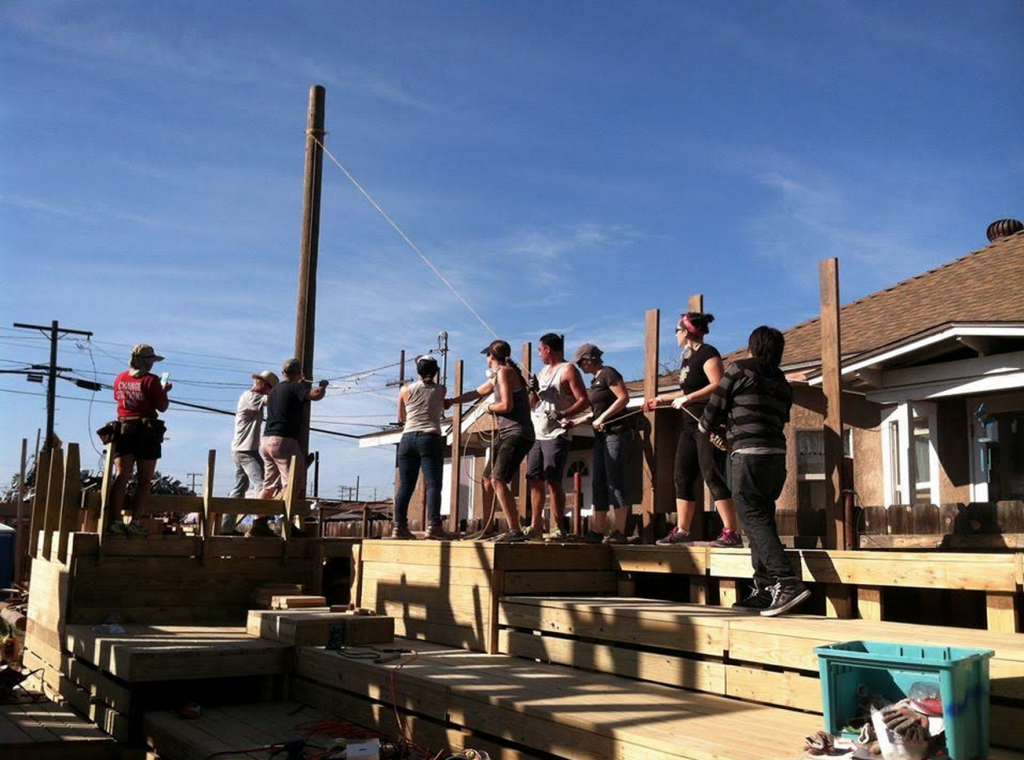By the time Avital Aboody started scouting vacant lots in the Logan Heights neighborhood of San Diego, she’d long since fallen in love with the neighborhood. A BAME Community Development Corporation staffer at the time, with a background in social justice community organizing, she’d been working in the underserved community for several years, and knew all too well how much it needed green spaces, parks, community gathering areas. Everyone knew it, and everyone talked about it. But nothing was changing.

It didn’t seem like help was going to come from the top down. “Structural racism, I think,” says Aboody. “We’ve been advocating for more parks in the community planning process, and the city budget process, and there’s always some excuse. ‘Oh, we don’t’ have the funding for that,’ or ‘there’s other priorities.’ Meanwhile, other neighborhoods do get funding for parks.”
So she kept a close eye on those vacant lots. “It’s a pretty dense neighborhood,” explains Aboody, who’s now the Economic Development Manager at City Heights Community Development Corporation, and a volunteer member of the H.A.C.E.R. steering committee, “with these random vacant lots here and there, in between houses and businesses. It’s not big swaths of land. But it’s enough that if you start looking at it and thinking wow, this could all be gardens or parks or something public, then it’s pretty significant at that point.”
Rather than continuing to pass by the vacant lots each day, and continuing to wonder about them, Aboody did something actually pretty radical. Something every single one of us has the power and the right to do in our own neighborhoods. She took action. She made it her business to find out about the lots. She created a database of vacant lots in area, sought out owners, made calls, and dug into public records. She asked around.

A mystery unveiled
There was one lot that particularly interested Aboody. Strategically placed next to two restaurants in the heart of the neighborhood, it got lots of traffic. For a community gathering space, you couldn’t do better. “Honestly, this lot,” says Aboody, “nobody knew who owned it for a long time. I had been eyeing it for a while. So I just started digging around and going to the county assessor’s office, and I found that it was in a trust.” With nothing more than a single mailing address to guide her search, Aboody dropped a letter in the mail, to inquire.
Amazingly, Aboody got a call from Derrick Gilliam, who doesn’t live in the neighborhood anymore but whose family owns the lot. Though his family no longer had an active presence in the community, it turned out that they have deep roots there. His grandfather, the first African American judge in the high court in San Diego, was a prominent figure in the city.
“The neighborhood used to be the center of the black community in San Diego,” explains Aboody, “and was really the heart of all the black owned businesses. That started shifting in the 60s when discriminatory housing covenants changed and more Latino immigrants began settling into Logan Heights. Now the community is predominantly Latino The land became less valuable, people moved on, and nobody was really paying attention to these spaces anymore. But it’s not immune to gentrification. It’s on the verge. You can tell that some of these owners are just holding onto properties and letting them look a little shabby, and waiting for that moment.”
Gilliam was wonderfully open to brainstorming about what the lot could be used for. “It was a really easy conversation, actually,” Aboody says, “which was surprising. He was like ‘you know, that makes sense, and we’re not using it for the forseeable future, and I think it’s a good idea.’”
And so the H.A.C.E.R. Project (Helping Achieve Community Empowerment and Revitalization), at the Gilliam Family Community Space & Garden, was born. BAME CDC, along with their design and architecture partner, Space 4 Art, now have a 5-year lease on the lot, and hope that this will only be the beginning.

What will the community space look like?
Well, pretty fabulous. The project is nearing completion, at this point, with a three-story tree house, amphitheater, and maze underway. It’ll also feature “shade trees,” made of reclaimed bicycle wheel “leaves” and reclaimed utility pole “trunks,” which Aboody acquired simply by asking some utility workers what they planned to do with those poles they were removing for utility undergrounding in a nearby neighborhood. We see a trend here; the squeaky wheel really does get the grease. Ask, ask, ask; it’s something we could all do more of.
Residents can also look forward to an outdoor movie screen (movie nights!), and several raised garden beds as learning tools for future urban gardening projects.
Want to get involved? Check out the project’s ioby campaign page for more info, or to donate, or to watch an awesome short video about the community space. Or come and lend a hand at one of the last few volunteer workdays:
Wednesday, October 14, 9am-5pm
Thursday, October 29, 9am-5pm
Friday, October 30, 9am-5pm
Dates and time slots may shift slightly, depending on weather and project needs, so if you’re considering joining in, shoot an email over to Hacerproject@gmail.com ahead of time, to get the latest.
Feeling inspired? Want to take action in YOUR neighborhood? If you have awesome ideas about how to make your town greener, safer, and more fun, let us help! Tell us your awesome idea right here. We’d love to help you get started today.
Pssst…. In OTHER ioby news:
Did you know that NYC is turning the country’s largest deactivated landfill into a gorgeous new green space that’ll be 2 ½ times the size of Central Park? STINK NO MORE. Check out some of the exciting changes afoot at Freshkills Park, on Staten Island.